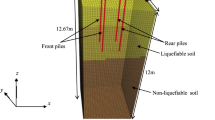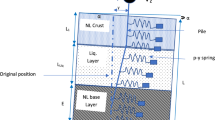Abstract
Dynamic analyses of piles subjected to both vertical and horizontal loading under seismic conditions are of great significance to geotechnical and practicing engineers and the numerical methodology proposed in the present study fills the existing research gap. A finite difference based computer program FLAC3D is used to model a single pile and obtain the deflection and bending moment behaviour along the depth of the pile, under earthquake loading conditions in both non-liquefiable and liquefiable soil. The various earthquake motions considered in the current analysis includes 1989 Loma Gilroy, 1995 Kobe, 2001 Bhuj and 2011 Sikkim motions The bending moment is maximum at the interface of the liquefying and non-liquefying soil layers due to shear strain in the soil being discontinuous across the interface of the layers. The free field ground surface displacement is observed to initially increase with time, reaching the maximum at some instant during shaking and thereafter it remains constant with time, due to local failure of the liquefiable soil around the pile foundation. The combination of vertical load and lateral load on the pile top is varied to obtain the P-delta curves under dynamic loading conditions which are important factors for peak pile bending moment, when there is lateral spreading due to liquefaction causing displacement of the pile head, and inertial load from the superstructure is present. Hence a thorough evaluation of both horizontal and vertical inertial interactions and kinematic interactions due to free field motions, is necessary for considering the behaviour of piles in liquefiable soil and under combined loading situations.




(Modified after Abdoun et al. 2003)










Similar content being viewed by others
Abbreviations
- l :
-
Pile length
- d :
-
Pile diameter
- x :
-
Deflection in pile
- M :
-
Moment generated in the pile
- M max :
-
Maximum bending moment generated in the pile
- δ :
-
Interface friction angle
- θ :
-
Angle between the ground surface with the horizontal
- ϕ :
-
Soil friction angle
- k n :
-
Normal stiffness
- k s :
-
Shear stiffness
- G :
-
Low strain shear modulus
- L liq :
-
Thickness of the liquefiable soil layer
- r o :
-
Radius of the pile
- μ :
-
Poisson’s ratio
- V :
-
Vertical load applied at the pile top
- H :
-
Pseudo-static horizontal inertial load acting at the pile top
- D r :
-
Relative density of the soil
- L 1, L 2 :
-
Hysteresis default model parameters
- M w :
-
Moment magnitude of the earthquake
- a max :
-
Bedrock level acceleration
- f :
-
Amplification factor
- E p :
-
Young’s modulus of elasticity of pile
- E s :
-
Young’s modulus of elasticity of soil
- ρ :
-
Density
- e max :
-
Maximum void ratio
- e min :
-
Minimum void ratio
- G s :
-
Specific gravity
- c u :
-
Cohesion
- k :
-
Coefficient of permeability
- γ :
-
Unit weight
- C 1, C 2 :
-
Byrne model parameters
- \(\Delta \in_{vd}\) :
-
Incremental volume decrease,
- \(\in_{vd}\) :
-
Irrecoverable volumetric strain
- V ult :
-
Ultimate pile capacity
- V all :
-
Allowable capacity of a single pile
- P-Δ :
-
Load-deflection
- P :
-
Axial load in the pile at a particular depth
- A :
-
Cross sectional area of the pile
- I :
-
Moment of inertia of the pile
- y :
-
Maximum distance from the neutral axis
- σ max :
-
Maximum stress generated in the pile
- σ per :
-
Permissible tensile stress at yield
- r u :
-
Excess pore water pressure ratio
References
Abdoun T, Dobry R, O’Rouke TD, Goh SH (2003) Pile foundation response to lateral spreads: centrifuge modelling. J Geotech Geoenviron Eng ASCE 129(10):869–878
ASTM (American Society for Testing and Materials) D638 (2010) Standard test method for tensile properties of plastics. ASTM International, West Conshohocken
ASTM (American Society for Testing and Materials) D792 (2008) Standard test methods for density and specific gravity (relative density) of plastics by displacement. ASTM International, West Conshohocken
ASTM (American Society for Testing and Materials) E132 (2004) Standard test method for Poisson’s ratio at room temperature. ASTM International, West Conshohocken
Bhattacharya S, Madabhushi SPG (2008) A critical review of methods for pile design in seismically liquefiable soils. Bull Earthq Eng 6(3):407–446
Bhattacharya S, Madabhushi SPG, Bolton MD (2004) An alternative mechanism of pile failure in liquefiable deposits during earthquakes. Geotechnique 54(3):203–213
Bhattacharya S, Adhikari S, Alexander NA (2009) A simplified method for unified buckling and free vibration analysis of pile-supported structures in seismically liquefiable soils. Soil Dyn Earthq Eng 29:1220–1235
Boominathan A, Ayothiraman R (2005) Dynamic behaviour of laterally loaded model piles in clay. Proc Inst Civ Eng Geotech Eng 158(GE4):207–215
Bouckovalas G, Chaloulos Y (2014) Kinematic interaction of piles in laterally spreading ground. Bull Earthq Eng 12(3):1221–1237
Bowles JE (1997) Foundation analysis and design, 5th edn. McGraw-Hill Inc, New York
Byrne P (1991) A cyclic shear-volume coupling and pore-pressure model for sand. In: proceedings of 2nd international conference on recent advances in geotechnical earthquake engineering and soil dynamics. St. Louis, Missouri, pp 47–55
Chatterjee K (2018) Impact of ground response analysis on seismic behavior and design of piles in Kolkata city. Indian Geotech J 48(3):459–473
Chatterjee K, Choudhury D (2018a) Influences of local soil conditions for ground response in Kolkata city during earthquakes. Proc Natl Acad Sci India Sect A 88(4):515–528
Chatterjee K, Choudhury D (2018b) Influence of seismic motions on behaviour of piles in liquefied soils. Int J Numer Anal Methods Geomech 42(3):516–541
Chatterjee K, Choudhury D, Poulos HG (2015a) Seismic analysis of laterally loaded pile under influence of vertical loading using finite element method. Comput Geotech 67:172–186
Chatterjee K, Choudhury D, Rao VD, Mukherjee SP (2015b) Dynamic analyses and field observations on piles in Kolkata city. Geomech Eng Int J 8(3):415–440
Choudhury D, Phanikanth VS, Mhaske SY, Phule RR, Chatterjee K (2015) Seismic liquefaction hazard and site response for design of piles in Mumbai city. Indian Geotech J 45(1):62–78
Cubrinovski M, Ishihara K, Poulos HG (2009) Pseudostatic analysis of piles subjected to lateral spreading. Bull N Z Society Earthq Eng 42(1):28–38
Dash SR, Bhattacharya S, Blakeborough A (2010) Bending-buckling interaction as a failure mechanism of piles in liquefiable soils. Soil Dyn Earthq Eng 30(1–2):32–39
Dobry R, O’Rourke MJ (1983) Discussion on seismic response of end-bearing piles by R Flores-Berrones and RV Whitman. J Geotech Engineering Div ASCE 109(5):778–781
Dobry R, Abdoun T, O’Rourke TD, Goh SH (2003) Single piles in lateral spreads: field bending moment evaluation. J Geotech Geoenviron Eng ASCE 129:879–889
Dowling J, Finn WDL, Ventura CE, Taiebat M (2016) Load distribution in large pile groups under static and dynamic loading. Bull Earthq Eng 14(6):1461–1474
FLAC3D (2009) Fast Lagrangian Analysis of Continua. Version 4.0. Itasca Consulting Group, Minneapolis, Minnesota, USA
Haldar S, Babu GLS (2010) Failure mechanisms of pile foundations in liquefiable soil: parametric study. Int J Geomech ASCE 10(2):74–84
IS (Indian Standard Code) 2911 Part1 Section 4 (1984) Indian standard code of practice for design and construction of pile foundations. Bureau of Indian Standards, New Delhi
Karthigeyan S, Ramakrishna VVGST, Rajagopal K (2006) Influence of vertical load on the lateral response of piles in sand. Comput Geotech 33:121–131
Knappett JA, Madabhushi SPG (2012) Effects of axial load and slope arrangement on pile group response in laterally spreading soils. J Geotech Geoenviron Eng ASCE 138:799–809
Kramer SL (1996) Geotechnical earthquake engineering. Prentice Hall, Upper Saddle River
Kumar A, Choudhury D (2016) DSSI analysis of pile foundations for an oil tank in Iraq. Proc Inst Civ Eng Geotech Eng 162(2):129–138
Kumar A, Choudhury D, Katzenbach R (2016) Effect of earthquake on combined pile-raft foundation. Int J Geomech ASCE 16(5):04016013-1–04016013-16
Liyanapathirana DS, Poulos HG (2005a) Seismic lateral response of piles in liquefying soil. J Geotech Geoenviron Eng ASCE 131:1466–1479
Liyanapathirana DS, Poulos HG (2005b) Pseudo-static approach for seismic analysis of piles in liquefying soil. J Geotech Geoenviron Eng ASCE 131:1480–1487
Mylonakis G (2001) Simplified model for seismic pile bending at soil layer interfaces. Soils Found 41(4):47–58
Nikolaou S, Mylonakis G, Gazetas G, Tazoh T (2001) Kinematic pile bending during earthquakes: analysis and field measurements. Geotechnique 51(5):425–440
Phanikanth VS, Choudhury D, Reddy GR (2013) Behaviour of single pile in liquefied deposits during earthquakes. Int J Geomech ASCE 13(4):454–462
Rovithis E, Mylonakis G, Pitilakis K (2013) Dynamic stiffness and kinematic response of single piles in inhomogeneous soil. Bull Earthq Eng 11(6):1949–1972
Seed HB, Idriss IM (1970) Soil moduli and damping factors for dynamic response analyses. Report. No. EERC-70/10, Earthquake Engineering Research Center, University of California, Berkeley, USA
Timoshenko SP, Goodier JN (2002) Theory of elasticity, 3rd edn. Tata McGraw-Hill Education, New York
Author information
Authors and Affiliations
Corresponding author
Additional information
Publisher's Note
Springer Nature remains neutral with regard to jurisdictional claims in published maps and institutional affiliations.
Rights and permissions
About this article
Cite this article
Chatterjee, K., Choudhury, D., Rao, V.D. et al. Seismic response of single piles in liquefiable soil considering P-delta effect. Bull Earthquake Eng 17, 2935–2961 (2019). https://doi.org/10.1007/s10518-019-00588-2
Received:
Accepted:
Published:
Issue Date:
DOI: https://doi.org/10.1007/s10518-019-00588-2




